Last Updated on January 29, 2024 by Soumya
Looking for fun facts about Chichen Itza Mexico? Searching for interesting things about the Chichen Itza pyramid?
Digging for Chichen Itza mysteries? I am glad to say that your search ends here.
Here’s the most complete Chichen Itza Facts Guide on the internet that’ll not only give you the 15 most cool things about the history of Chichen Itza but also get you to think deeper.
Chichen Itza is not just any ancient Mayan pyramid in the Yucatan peninsula of Mexico. It is massive and a world wonder. It is also one of the most visited archaeological sites in the entire world. And, it is one of the most mysterious!
While researching for my visit to this world wonder, I discovered so many interesting facts about Chichen Itza that I was quite surprised.
And honestly, some of these amazing things about Chichen Itza kept me gaping. Wide!
I hope that you will find this collection of cool (and sometimes unsavory) Chichen Itza facts intriguing and fascinating.
Please note: This post may contain affiliate links which means I may earn a commission if you make a purchase by clicking a link on this post. This will be at no additional cost to you. Affiliate links help me keep this website up and running. Thanks for your support!
Interesting Facts about Chichen Itza
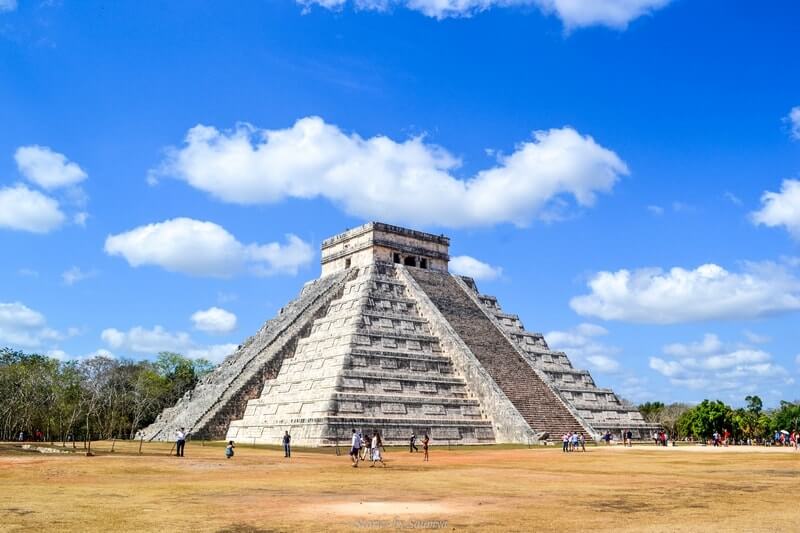
Chichen Itza was once a sprawling Mayan city bubbling with trade, activity, and public life.
While most of us only know of the tall Mesoamerican stepped pyramid called the El Castillo or the Temple of Kukulkan, there are so many facets to Chichen Itza that one must discover.
But everything that will get you itching a little more to see this world wonder for yourself. Let’s see if these amazing Chichen Itza facts and its long history thrill, surprise, or shock you.
Chichen Itza was not entirely Mayan.
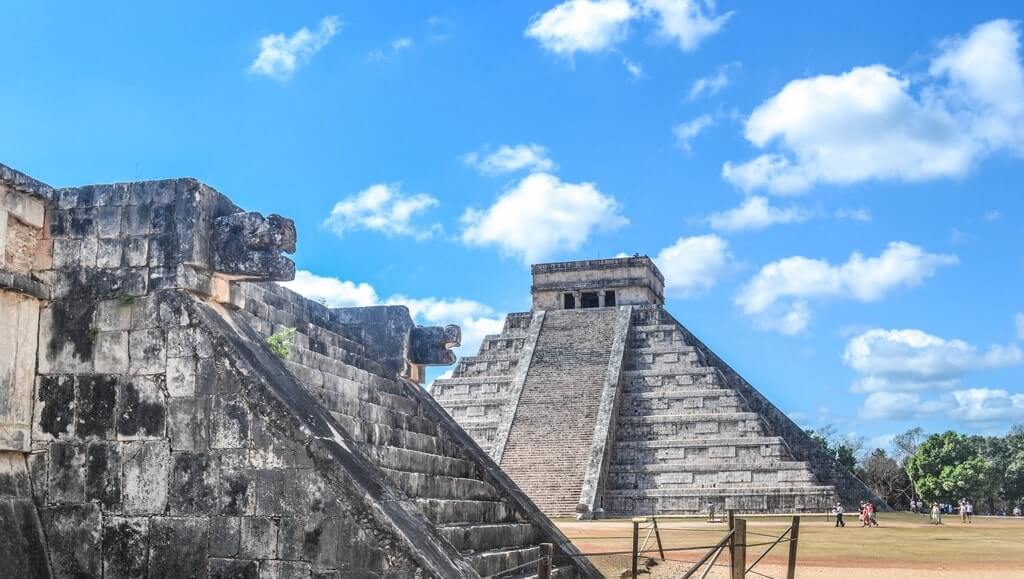
Now, did that jolt you? Well, it did startle me when I first learned of it.
It is true that Chichen Itza was built in two stages – the Pre-Classic or Formative period which was completely dominated by the Mayan Civilization and the latter period where there were a number of influences of the Toltec regime.
According to National Geographic and a number of other sources, the Toltecs invaded Chichen Itza in the 10th century. The most recognizable structure, the Temple of Kukulkan was built after that and hence, shows a strong Central Mexican influence.
A conflicting theory indicates that these influences were because of strong trade relations between the Mayans and the Toltecs.
Nevertheless, the Toltec influence was strong. The most iconic monuments of Chichen Itza – The Pyramid of Kukulkan, the Temple of Warriors, and the Great Ball Court – are of the Toltec style.
✦ Pro Tip: Interested in learning more about ancient Mexican pyramids? Check out our article on the 20 most fascinating pyramids of Mexico.
The main pyramid nests multiple smaller pyramids inside it.
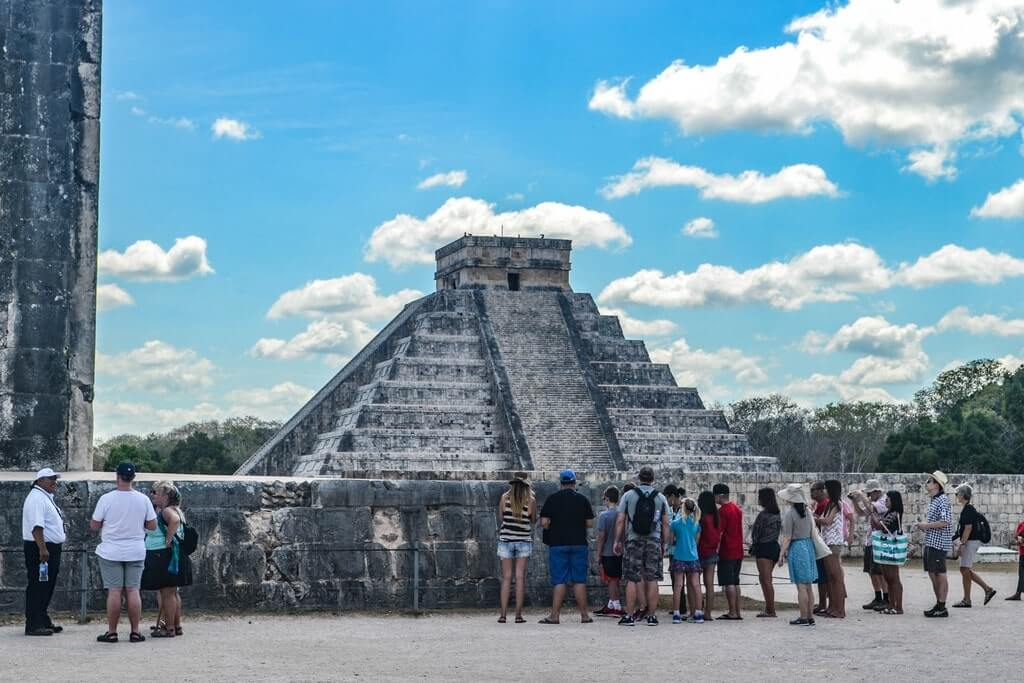
According to the Guardian, the Kukulkan Pyramid (30 meters in height) nests within itself two smaller pyramids (20 meters and 10 meters tall).
Scientists have compared El Castillo (Kukulkan’s Pyramid) to the Russian nesting dolls. This was one of the most stunning facts about Chichen Itza that I discovered during my research.
The smallest pyramid was probably built during the original Mayan reign before the Toltec invasion. Researchers believe that it could help us understand the Mayan culture’s original style and customs.
Chichen Itza was part of the Great Maya Aquifer Project?
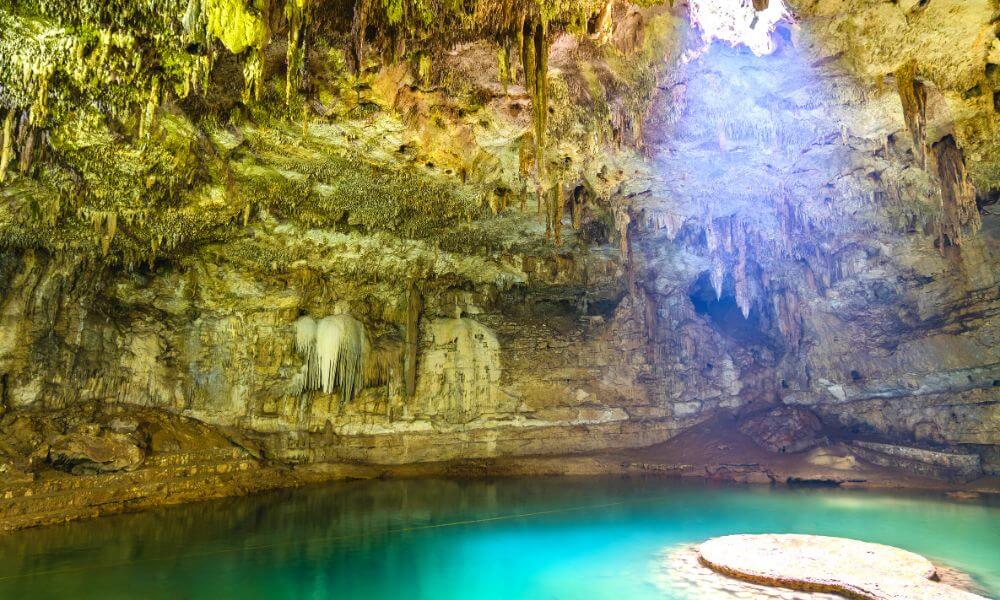
[Image credits: Leonid Andronov via Canva Pro]
A recent discovery of an ancient cave full of artifacts at Chichen Itza points to an interesting fact. Chichen Itza was part of the Great Maya Aquifer Project!
Archeologists discovered a cave system known as “Balamku” meaning Jaguar God (see the connection with Ek Balam here) in March 2019. More than 150 Mayan artifacts, several dedicated to the Rain God, Tlaloc, have been discovered here.
Balamku was possibly a part of the Great Aquifer Project of the Mayans that once connected Chichen Itza to the entire nexus of Mayan cities in the Yucatan Peninsula.
The aquifer project included several cenotes and underground caves that not only supplied water to the people but were also an integral part of Mayan religious beliefs.
Monuments of Chichen Itza were astronomically aligned.
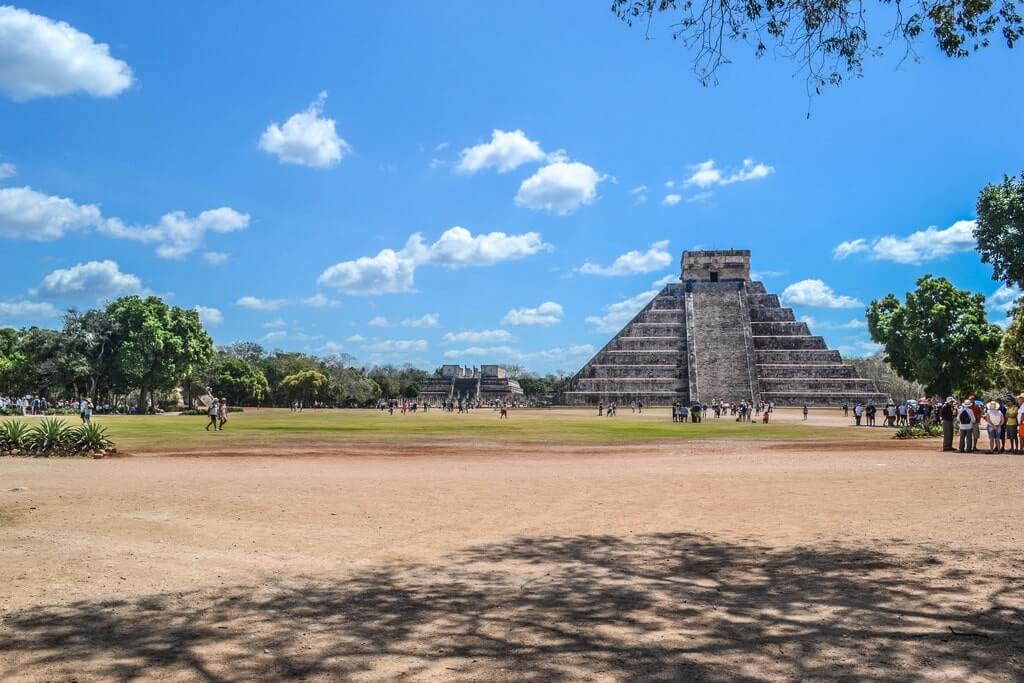
The Mayans were strong believers and followers of astronomy. This is quite evident in how and why they built their monuments.
At Chichen Itza, you can see a round-shaped observatory, the El Caracol, which was specifically used to gauge the positions of planets and the sun.
Further, the most iconic landmark – the Pyramid of Kukulkan has 365 steps in total – 91 on each side and one at the top. This equals the number of days in a year.
Each side represented one season and was used to figure out the best times for sowing seeds and harvesting crops. The huge pyramid, in fact, functioned as one big calendar.
📖 Related Read: Mayans always aligned their cities with the sun and the stars. Check out the ruins of Ek Balam for more evidence on astronomical alignment.
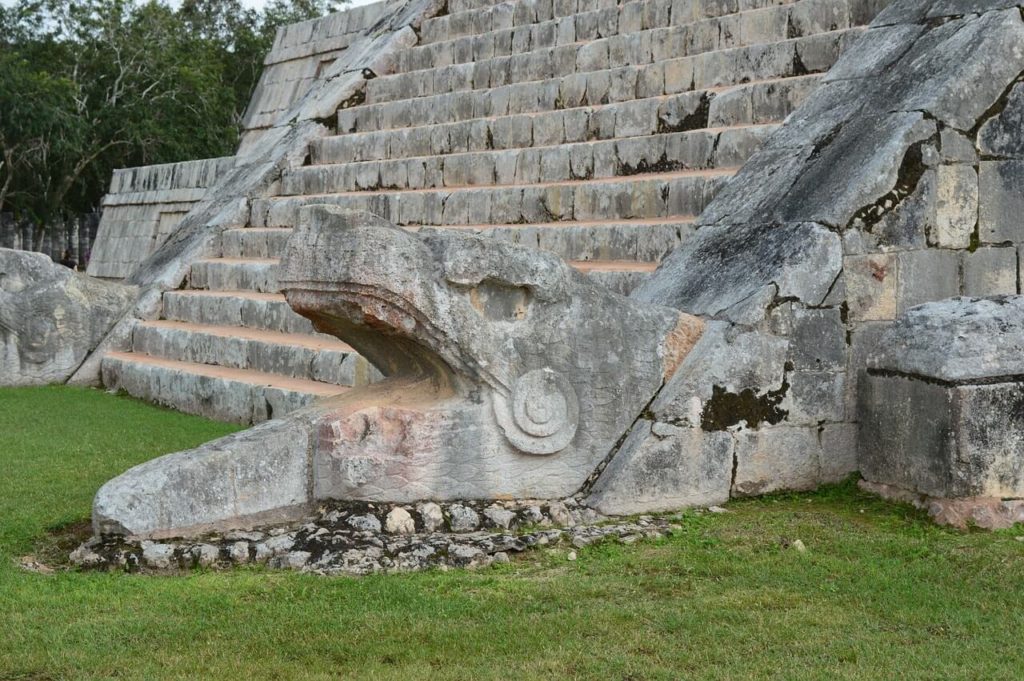
The Serpent God, Kukulkan descends on the pyramid twice every year
The Temple of Kukulkan was so designed that every year, the sun forms the shadow of a serpent (is that the mythical Mayan Serpent God, Kukulkan??) on the pyramid during the spring and autumn equinoxes.
The undulating shadow, resembling the body of a snake, slowly moves down as the sun sets before merging with the serpent head at the bottom of the stairs.
Now, that one gave me some goosebumps. Didn’t it?
I can imagine the religious and ceremonial significance that the equinoxes must have held for the Mayan people.
It is, literally, like seeing your God come alive.
Even today, hundreds of locals and tourists flock to Chichen Itza to witness this surreal phenomenon. This was the most unusual one among all the Chichen Itza facts I discovered.
Was there an elite residential complex in Chichen Itza?
Earlier our knowledge of Chichen Itza was only restricted to pyramids, temples, observatories, ball courts, and marketplaces.
Even though these structures provide us with interesting facts about Chichen Itza’s public life, we barely know anything about private residences in the area. But seems like that is going to change very soon.
Archeologists have now unearthed ruins of an elite residential complex in Chichen Itza.
Complete with entrance arches and lived-in mansions, this discovery could lead us to find out more about the private lives of ancient Mayans. Read the complete report by Smithsonian Magazine here.
Gruesome death practices were openly flaunted in Chichen Itza.
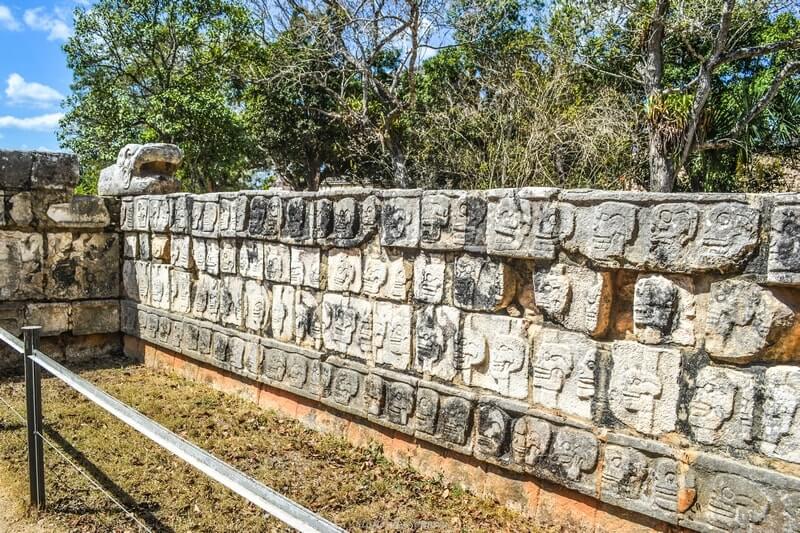
The land of the Mayans was not only about fun and festivities.
It was a lot about gruesome sacrifices and brutal death penalties. Quite similar to what we saw at the Pyramids of Teotihuacan and the Colosseum in Rome.
Many structures in Chichen Itza are a testimony to these practices.
The Platform of Skulls or a Skull Rack (Tzompantli) is the most ominous. Hundreds of heads of victims and soldiers were carved onto the walls of the platform to control people and scare enemies.
Until 2006, tourists were allowed to climb the Chichen Itza Pyramid.

The pyramid was banned to climbers in January 2006 when a woman tumbled to death while descending the steps. It was an unfortunate incident.
The pyramid has now been roped off and can only be adored from a distance. And I feel this is healthy for both the visitors and the monument.
It is easy to feel a surge of adrenaline when you climb up these ancient monuments. Once on top, you can appreciate the magnificent vistas of the Yucatan peninsula. Maybe you can spot another pyramid or two.
But climbing is not easy. The way down is especially difficult with the steps having been smoothened over centuries. And it erodes the structures so much more.
✦ Pro Tip: More and more pyramids in Mexico are being cordoned off now. The only Mayan ruin near Cancun that’s still open to climbing is the El Castillo at Ek Balam.
Fun Facts about Chichen Itza
The famous archaeological site of Chichen Itza was awarded UNESCO World Heritage Site status in 1988. It went on to be listed as one of the Seven Wonders of the World in 2007.
But in this article, we are not going to talk about that. Instead, we are going to look at some unknown and fun Chichen Itza facts that could change how you think about this magnificent site.
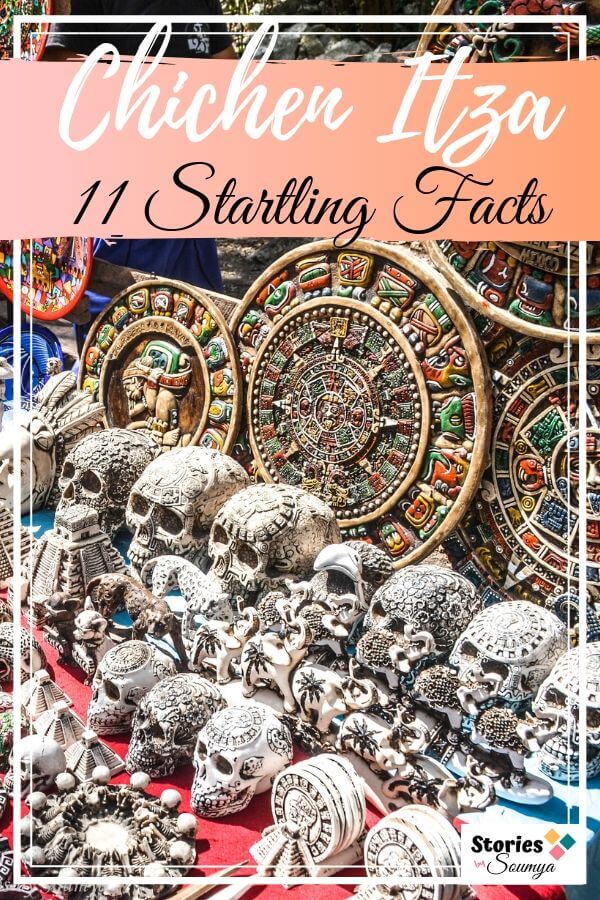
Chichen Itza was home to over 50,000 people!
At its apogee in the 9th century, more than 50,000 people lived in the Mayan capital city of Chichen Itza.
It is believed that large-scale migrations from parts of Central Mexico, Belize, and Guatemala were also happening during this time.
Therefore, researchers believe that Chichen Itza’s population may have been fairly diverse though I doubt it would have been as diverse as that of Teotihuacan.
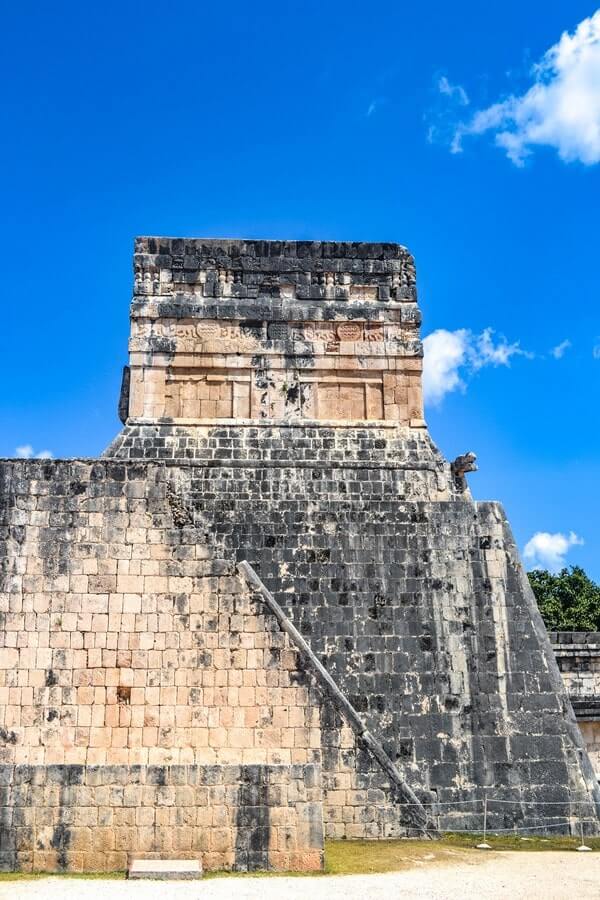
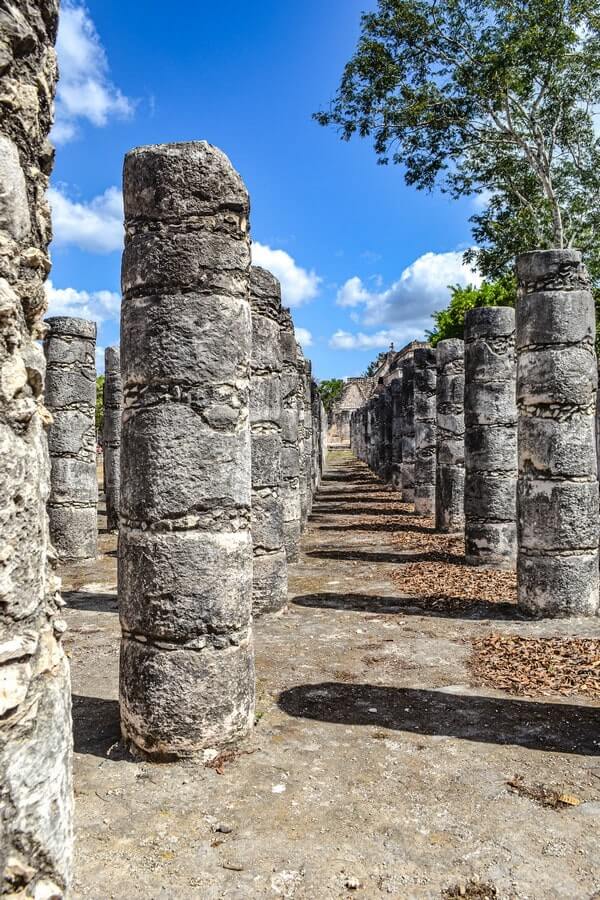
1000-year-old canoe found in Chichen Itza.
In a rare discovery, archeologists have found an ancient wooden canoe in Chichen Itza. The canoe is believed to be older than 1000 years!
Researchers believe that the Mayans used canoes to carry water from the cenotes and deposit religious offerings.
I can already imagine the Mayan aquifers filled with canoes ferrying people and goods throughout the Yucatan Peninsula, some 1500 years ago.
The canoe is quite well-preserved, given its age and material. According to INAH Mexico, this is the first complete Mayan canoe to be ever found.
Chichen Itza gets its name from a cenote nearby.
The Yucatan peninsula is full of natural cenotes.
A large cenote also called the Sacred Cenote and believed to have been used for sacrificial purposes at Chichen Itza is seen at the northern end of the archaeological site.
Chichen means “mouth of the wells” and Itza refers to the Mayan tribe that lived in these regions. Therefore, the city got its name from the well or cenote.
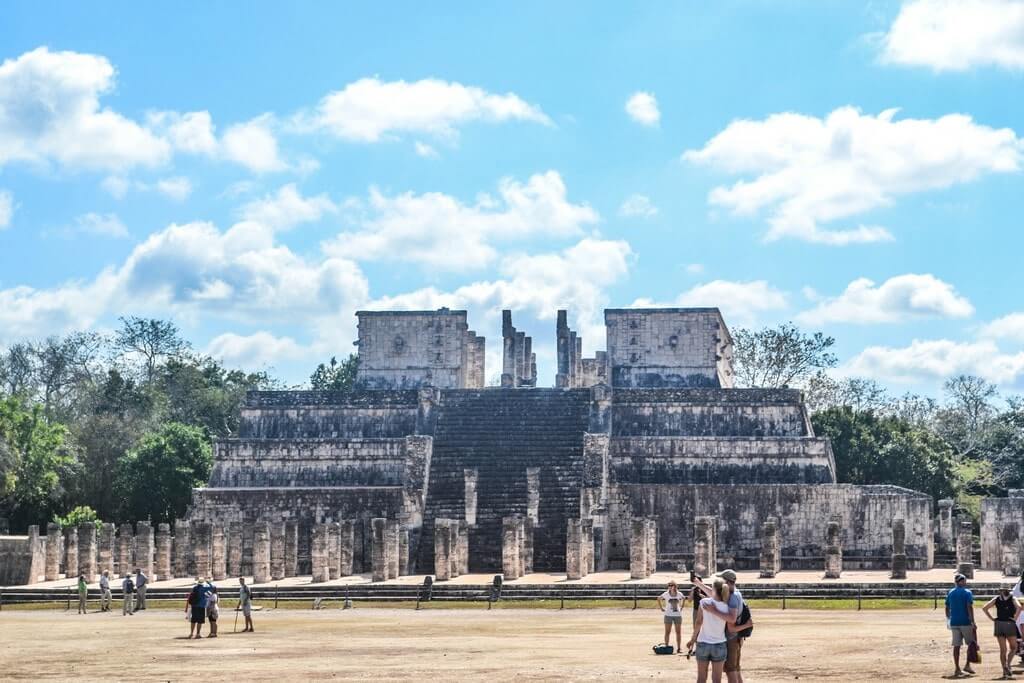
Apart from mysterious shadows, Chichen Itza is home to mysterious sounds!
Yes, you heard that right. You can hear strange sounds in the lost city of Chichen Itza.
If you clap your hands at the base of El Castillo’s stairs, you can hear an echo that is quite unlike anything else.
This echo resembles the warble of the Mexican quetzal, a bird that was considered sacred in the Mayan culture.
📖 Related Read: Keen to dig deeper? Read about how ancient Mayans could have engineered the Quetzal Effect in this article on Nature Journal.
Chichen Itza had the largest ball court in the Americas.
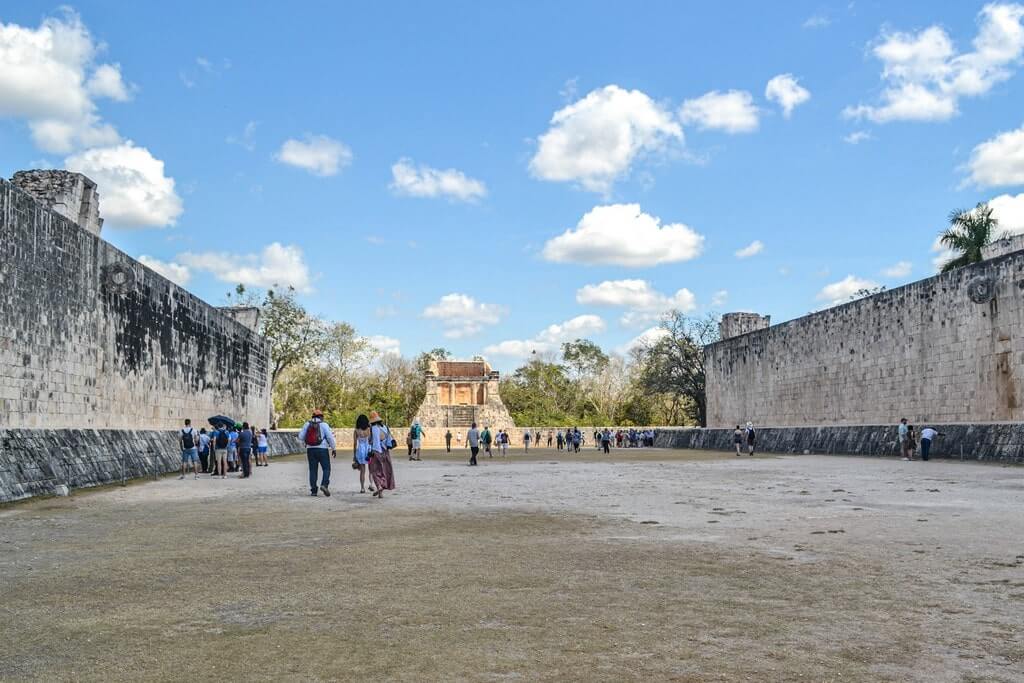
The Great Ball Court at Chichen Itza is the largest in the Americas.
The deadly but popular ball game of Mesoamerica was played here. The losers were decapitated at the end of the game. Not among the most pleasant Chichen Itza facts, I am sure.
While exploring the ball court, look up to spot stone rings on the walls of the court.
Players were required to shoot heavy rubber balls through these rings located at a height of 8 m from the ground. I wonder who could have achieved such a feat!
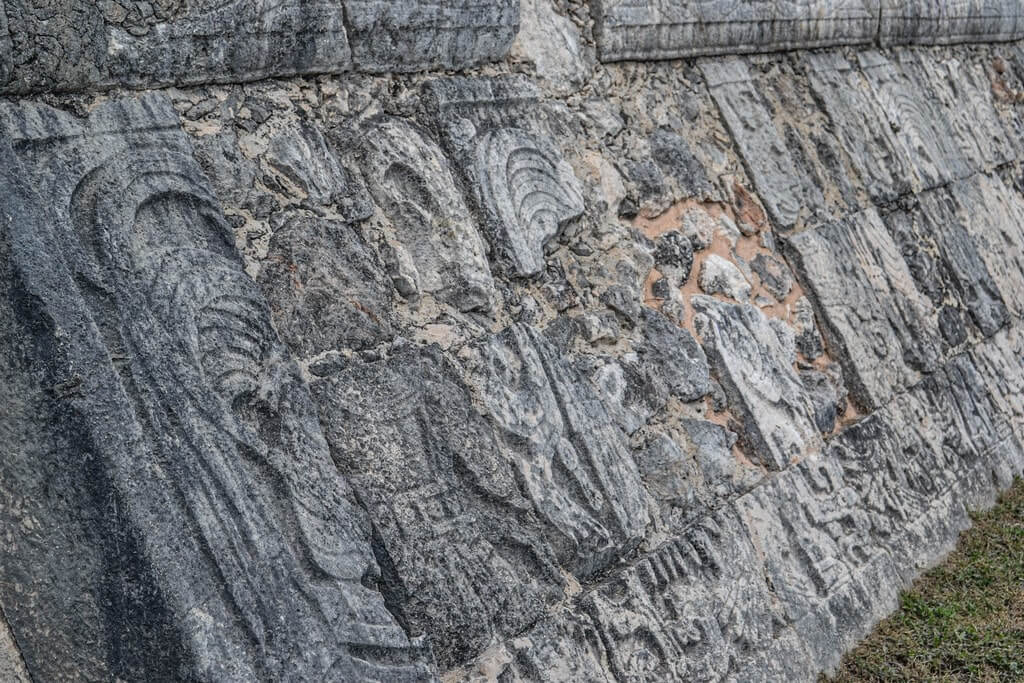
Chichen Itza was key in deciphering the secret behind remarkable Mayan blue color.
The Mayans invented an unusual blue color that has been extensively analyzed by scientists. The reasons – its extraordinary chemical stability and persistent color.
The Mayan blue can still be seen in the murals of Mayan temples. At a time when Lapiz Lazuli was prohibitively expensive, Mayans were producing tonnes of great quality, inexpensive Mayan blue.
The most important use of Mayan blue was in sacrifices. People were often covered entirely in blue and thrown into the Sacred Cenote of Chichen Itza.
Pottery, rubber, and wood – all covered in blue have also been found in the cenote. These findings were key to deciphering what went behind making Mayan blue so resilient.
Chichen Itza met a mysterious end.
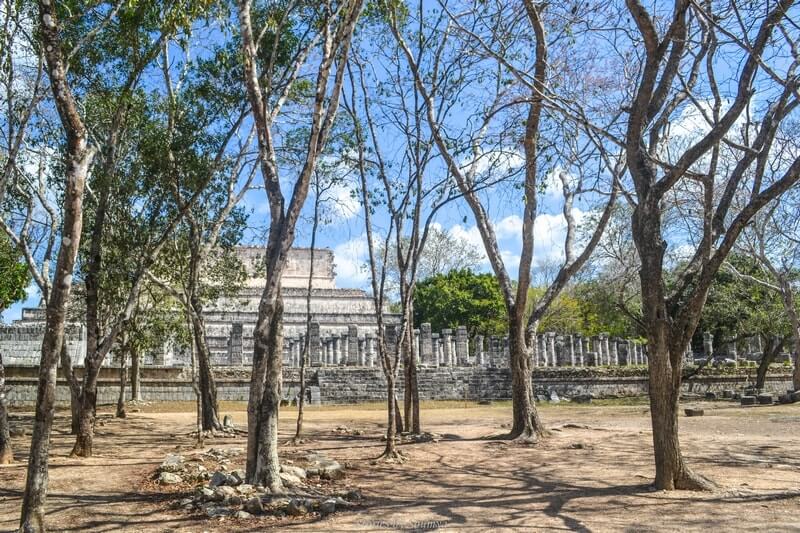
The glory of Chichen Itza declined and the city met a mysterious end in the 14th century. The residents moved out never to come back to the city again.
Researchers attribute this mass exodus to poor weather and a massive wave of droughts. Perhaps, the building of huge cities and rapid deforestation had led to climate change resulting in the decline of the Mayan civilization.
The, once prosperous, Mayan city of Chichen Itza had been lost to the jungles of Yucatan.
Chichen Itza Facts and History FAQ
Chichen Itza is one of the largest and most significant archaeological sites from the pre-Columbian Maya civilization. Located in the Yucatan Peninsula of Mexico, this ancient city is renowned for its intricate architectural styles reflecting both Maya and Central Mexican influences. The site’s most iconic structure is the magnificent pyramid known as El Castillo or the Temple of Kukulkan, a World Wonder.
Chichen Itza is special because it is home to the iconic Kukulkan Pyramid, also known as “El Castillo”, one of the most awe-inspiring creations by ancient Mayans. Chichen Itza is also one of the largest and most significant archaeological sites in Mexico’s Yucatan Peninsula. Therefore, it offers precious insights into the life and culture of the Mayan people.
Chichen Itza is believed to have been established around the 6th century CE. The city grew and developed from 600 CE to 1200 CE. Therefore, we can say that Chichen Itza is roughly 1,400 – 1,500 years old.
While the existence of Chichen Itza was always known to the local population, its existence was brought to the attention of the Western world by American explorer John Lloyd Stephens and British artist Frederick Catherwood. In 1843, their explorations, writings, and illustrations unveiled the magnificence of Chichen Itza, after which the site was studied in detail. Despite this, it’s crucial to note that they were not “discoverers” in the traditional sense, but rather the first to document and share these sites broadly outside the local context.
Chichen Itza was constructed in various phases, with the earliest believed to have begun around the 6th century CE. The city reached its architectural and cultural zenith between 900 – 1050 CE during the Terminal Classic period of Mexican history. and the early portion of the Postclassic period. This era witnessed the construction of most of the distinctive structures that we associate with the site today, including the impressive El Castillo or Kukulkan Pyramid.
Chichen Itza was built as a significant religious, political, and commercial center for the Mayan civilization. The city’s various structures were intricately planned and constructed to serve specific purposes, such as administrative centers, temples, and observatories for astronomical study. The Kukulkan Pyramid (El Castillo), with 365 steps, was specially built as a representation of the Mayan calendar.
According to popular reports, the ancient Mayan city of Chichen Itza was discovered in 1843 by two great explorers John Lloyd Stephens and Frederick Catherwood. To be precise, Chichen Itza and other iconic Yucatan pyramids came into limelight when Stephens and Catherwood documented their travels through these ancient ruins and published their first book Incidents of Travel in Central America, Chiapas and Yucatan in 1843. Even though many had come across the pyramid earlier, Stephens was the first to document it.
The pre-Columbian city of Chichen Itza was built by the Mayans native to the Yucatan peninsula. However, many different architectural styles, including Puuc and Toltec, found at the site suggest a strong influence of the Toltecs.
Chichen Itza is located in the Yucatan peninsula of Mexico. It is located at a distance of 120 miles (200 km) from the resort town of Cancun; therefore, often included as a day trip on Cancun itineraries.
Chichen Itza met a mysterious end between the 12th and the 15th centuries. Changing weather conditions, severe droughts, the rise of the Mayappans, and the arrival of diseases with the Spanish are said to have caused the decline of Chichen Itza.
Further Reading
- 14 Interesting Facts about the Pyramids of Teotihuacan, Mexico
- 20 Ancient Pyramids to Visit in Mexico
- 13 Mayan Ruins in Cancun that’ll fascinate the history lover in you
Loved our post on interesting facts about Chichen Itza? Pin it for later!
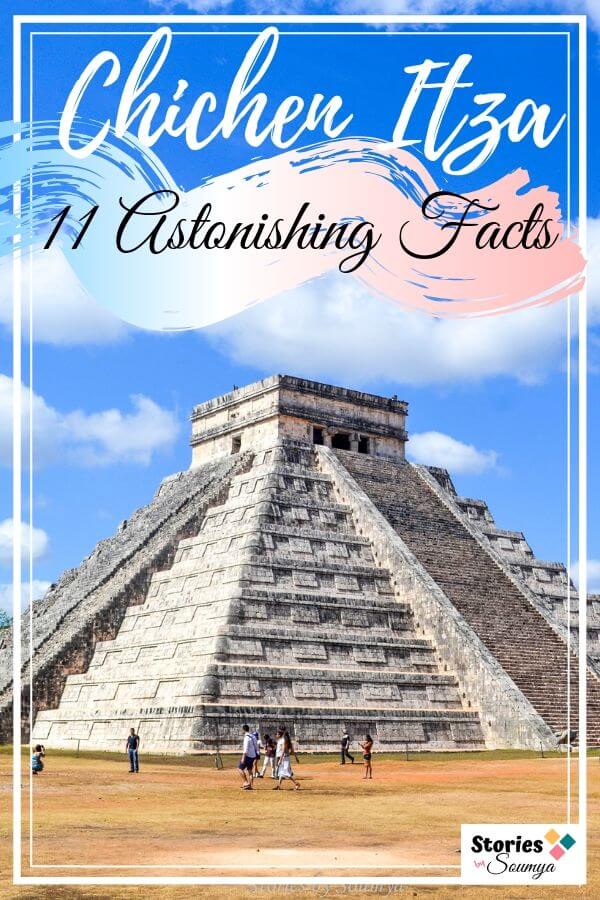
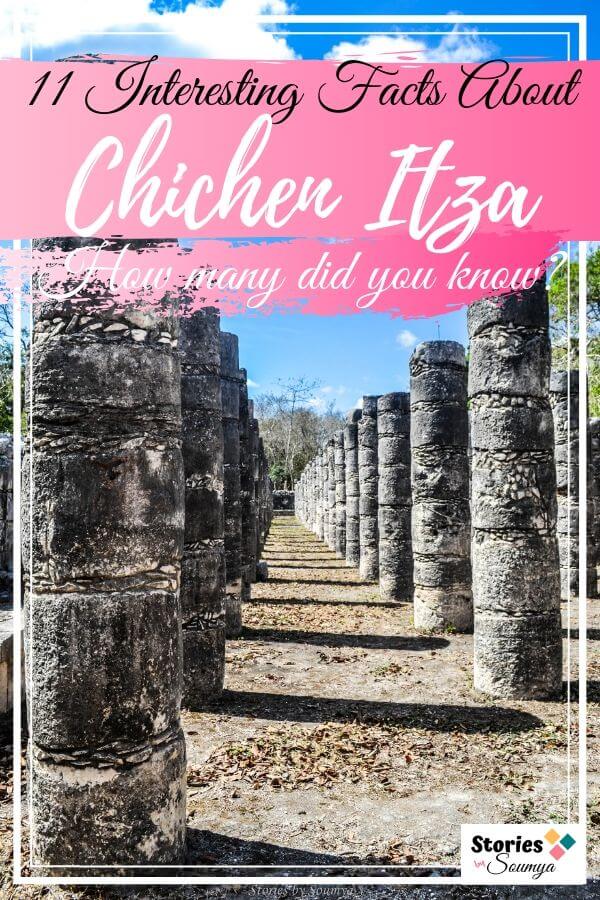

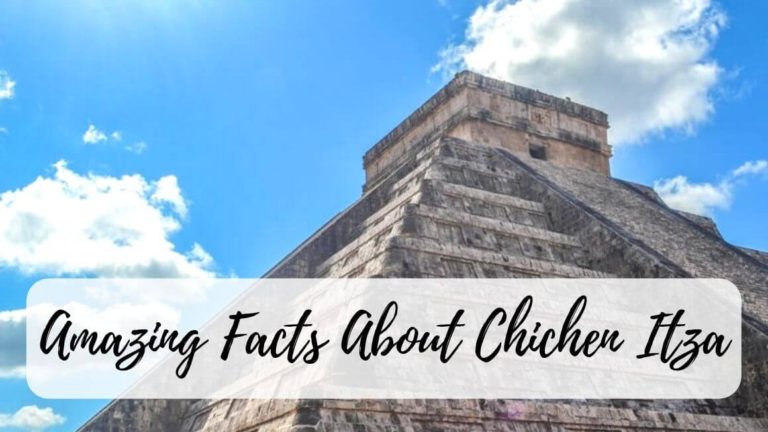

My husband and I took our two children in March of 2017. We had a guided tour by a local, and it was amazing. He described the games a little differently though. He said the “loser” was actually regarded as the winner, since it was such a great honor to be sacrificed.
Wow that’s an interesting perspective. I can understand that, in those times, it must be a big deal to be sacrificed in front of the Mayan gods.
I love the sounds fact, it’s quite mysterious. Will definitely try it because we’re heading there next month, I think we should print out this article to have experience all the details you described. Well done!
The sounds are quite mysterious, agreed. I would love to find out more about the Queztal bird too.
I got to know some really interesting facts about Chichen Itza and yes I agree I wasn’t aware of them before. The intense history of the place related to the Mayan blue seems interesting. Also the second and third pyramids inside the main pyramid in a Russian doll concept is something new to me. I am also surprised by the idea that it is more Toltec than Mayan.
It was all so surprising to me too when I started my research. So many legends. So many stories. Chichen Itza is definitely a storehouse of interesting facts.
Ah my wonderful Chichen Itza, such a gem to visit, even though it’s so touristy now. That said, I didn’t know about the serpent god story, that’s a little creepy! However, I do remember the stories about their ‘football’ game and being amazed at the size of the ball court. It’s definitely somewhere others should see when in this part of Mexico.
You are right. Chichen Itza is such a great mix of amazing and creepy facts!
I love these quirky facts! Need to time out my next visit to coincide with the Serpent God’s descent, would be a cool thing to see. I also want to see it at night! See if the sounds and shadows are any different during the light show 🙂
That would be a cool thing to find out. Let me know when you find out.
So many interesting facts. I love how they built these ancient structures along astronomical principles. Makes it so much more evocative when we visit today knowing how advanced they were hundreds of years ago.
That’s so true. It is just fascinating how they were such great astronomers thousands of years ago.
Mayan civilization has always fascinated me. I’ve heard about Chichen Itza, but I wasn’t aware of any of the facts you mentioned. It was quite an interesting read and really made me add this UNESCO site to my bucket list. I love the intriguing design and architecture of the pyramid – nesting multiple smaller pyramids inside, astronomically aligned and especially in a way that one can see the shadow of their Serpent God slowly move down the stairs – this is definitely an engineering marvel. Your echo resembling the warble of the sacred Mexican quetzal – this gives me goosebumps. I wish to explore this intriguing place in person some day.
Yeah so many intriguing things going on there. I hope you can visit soon. With your flair for history, I am sure you will love it.
Wow! I’m so surprised that Chichen Itza has been theorized not to be Mayan. That should be very interesting. I lvoe its structure and I really want to visit it. I hope I can book a flight soon and take a video of it. PS: Too bad I can’t climb El Castillo!
Well, it could be a mix of Mayan and Toltec. That’s the theory. And it is very interesting, that’s true. And yeah, climbing is no longer allowed here.
I did climb chicken about 15 years ago very steep steps and real small I had to hold on to a rope and go down back ward
Wow! Was it exciting or scary?
Chichen Itza looks to be both fascinating and creepy at the same time. You’ve made me want to visit the iconic site and person.
It is. Both fascinating and creepy!
The Mayan civilization and history holds a huge fascination for us.And of course ChichenItza is in many ways synonymous with this. The myths and facts that surround the place add to its charm and enigma. The serpent God Kukulkan sounds so much like the Nagas of Hindu mythology, and the symbolism to temples in India and Cambiodia.
You are so right. There is so much similarity between the two Gods. You would almost think there was some connection between the two.
I love Chichen Itza the legends, the history and the story. We visited during the day and returned for the light show in the evening. It is such a magical place. I remember our guide asking us to clap and did we hear the bird sound. Your article brought back lovely memories of our visit.
Wow the light show would have been magical. We missed that. Would love to see that one day.
Really informative and keeps the suspense till the end.
The concept of little known facts about Chichen Itza adds a lot of depth to your other article about Chichen Itza. 3 & 4 are awesome. I would love to see the snake god during an equinox. I’m going to skip the Skull and ball court, however, too macabre for me!
Yes, it was the same for me. Could not see the skull platform. The ball court was fine as long you don’t think about the games!